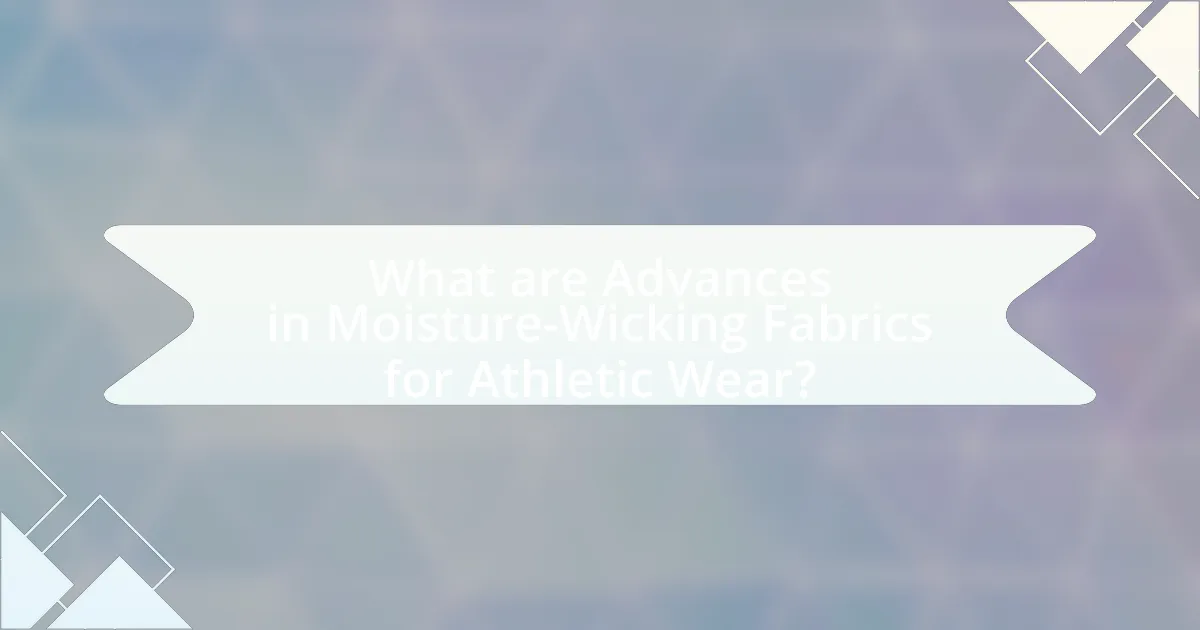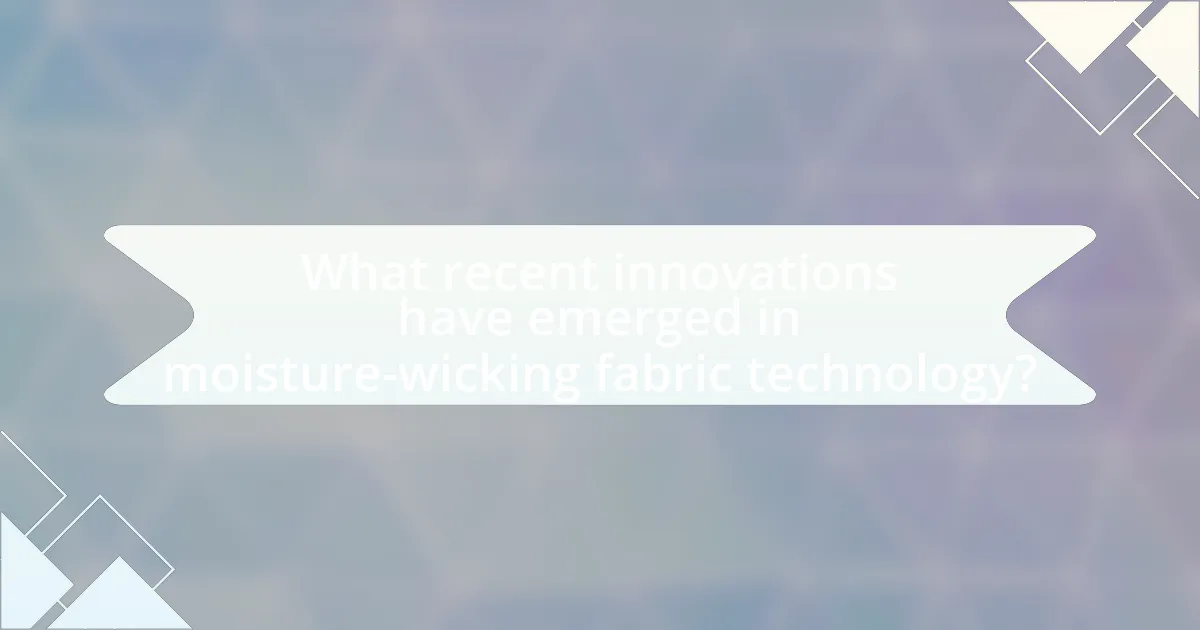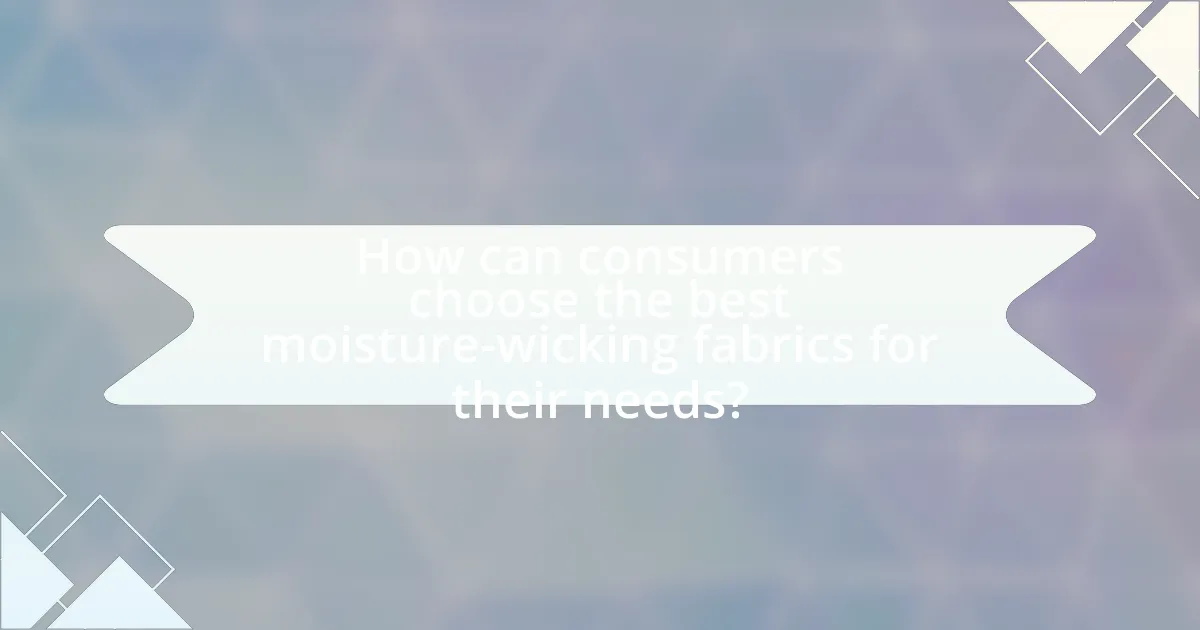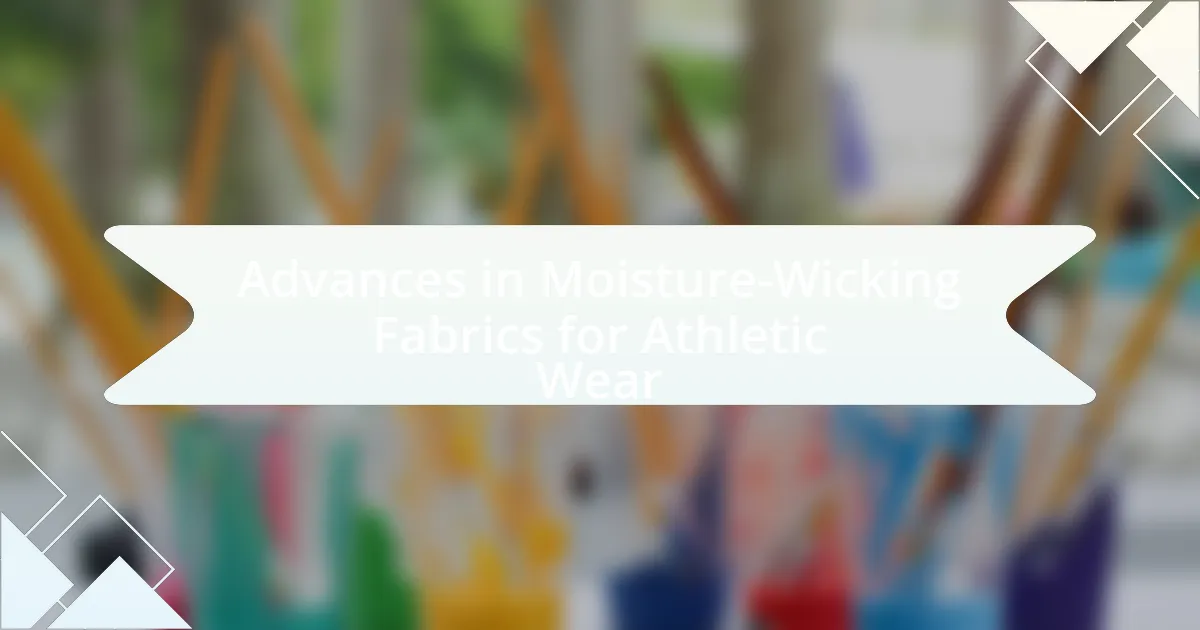Advances in moisture-wicking fabrics for athletic wear focus on the development of enhanced synthetic fibers that improve moisture management and breathability. Key innovations include advanced polyester and nylon blends with hydrophilic and hydrophobic properties, facilitating quicker sweat evaporation and incorporating antimicrobial treatments to reduce odor. The article explores how these fabrics function, the materials commonly used, and their benefits for athletes, such as improved comfort and performance. Additionally, it discusses recent technological advancements, sustainable practices, and consumer preferences shaping the future of moisture-wicking athletic wear.

What are Advances in Moisture-Wicking Fabrics for Athletic Wear?
Advances in moisture-wicking fabrics for athletic wear include the development of enhanced synthetic fibers that improve moisture management and breathability. Recent innovations involve the use of advanced polyester and nylon blends that feature hydrophilic and hydrophobic properties, allowing for quicker evaporation of sweat. For instance, brands like Under Armour and Nike have introduced fabrics with microfibers that increase surface area, facilitating faster moisture transfer away from the skin. Additionally, some fabrics now incorporate antimicrobial treatments to reduce odor, further enhancing the performance of athletic wear. These advancements are supported by research indicating that improved moisture-wicking capabilities can lead to better athletic performance and comfort during physical activities.
How do moisture-wicking fabrics function in athletic wear?
Moisture-wicking fabrics function in athletic wear by utilizing specialized fibers that draw moisture away from the skin to the fabric’s surface, where it can evaporate more easily. These fabrics are typically made from synthetic materials like polyester or nylon, which have hydrophobic properties that repel water. This design helps to keep athletes dry and comfortable during physical activity, reducing the risk of chafing and overheating. Studies have shown that moisture-wicking fabrics can significantly enhance performance by maintaining optimal body temperature and improving overall comfort during exercise.
What materials are commonly used in moisture-wicking fabrics?
Moisture-wicking fabrics commonly utilize materials such as polyester, nylon, and spandex. Polyester is favored for its ability to quickly draw moisture away from the skin, while nylon offers durability and breathability. Spandex is often blended with these materials to provide stretch and comfort, enhancing the overall performance of athletic wear. These materials are specifically engineered to enhance moisture management, making them ideal for high-intensity activities.
How does the construction of these fabrics enhance moisture management?
The construction of moisture-wicking fabrics enhances moisture management by utilizing specialized fibers and structures that promote rapid evaporation and moisture transfer away from the skin. These fabrics often incorporate hydrophobic materials that repel water, allowing sweat to be drawn away from the body and spread across the surface of the fabric, where it can evaporate more quickly. For instance, polyester and nylon blends are commonly used due to their ability to wick moisture effectively, as evidenced by studies showing that these materials can reduce skin temperature and improve comfort during physical activity.
What are the key benefits of moisture-wicking fabrics for athletes?
Moisture-wicking fabrics provide athletes with enhanced comfort, improved performance, and reduced risk of overheating. These fabrics are designed to draw sweat away from the skin to the outer surface of the material, where it can evaporate more easily. This process helps maintain a stable body temperature during physical activity, which is crucial for optimal performance. Studies have shown that athletes wearing moisture-wicking materials experience less chafing and irritation, leading to a more enjoyable workout experience. Additionally, moisture-wicking fabrics often incorporate antimicrobial properties, which help reduce odor and keep athletes feeling fresh throughout their activities.
How do these fabrics improve comfort during physical activities?
Moisture-wicking fabrics improve comfort during physical activities by effectively drawing sweat away from the skin to the fabric’s surface, where it can evaporate quickly. This process helps regulate body temperature and reduces the feeling of dampness, which can lead to chafing and discomfort. Studies have shown that fabrics made from synthetic fibers, such as polyester and nylon, are particularly effective in moisture management due to their hydrophobic properties, allowing for enhanced breathability and a cooler experience during intense workouts.
What impact do moisture-wicking fabrics have on athletic performance?
Moisture-wicking fabrics significantly enhance athletic performance by effectively managing sweat and moisture during physical activity. These fabrics draw perspiration away from the skin to the fabric’s surface, where it can evaporate more quickly, thus helping to regulate body temperature and maintain comfort. Research indicates that athletes wearing moisture-wicking materials experience reduced skin irritation and chafing, which can lead to improved focus and endurance during workouts. A study published in the Journal of Sports Sciences found that athletes reported a 20% increase in comfort levels when using moisture-wicking fabrics compared to traditional cotton, demonstrating a clear link between fabric technology and performance outcomes.

What recent innovations have emerged in moisture-wicking fabric technology?
Recent innovations in moisture-wicking fabric technology include the development of bio-based fibers and enhanced moisture management systems. Bio-based fibers, such as those derived from recycled plastics or agricultural waste, have been engineered to improve breathability and moisture transfer, making them more sustainable and effective for athletic wear. Enhanced moisture management systems utilize advanced knitting techniques and hydrophilic/hydrophobic treatments to optimize the movement of sweat away from the skin, ensuring quicker drying times and increased comfort during physical activity. These advancements are supported by research indicating that such fabrics can significantly improve athletic performance by maintaining optimal body temperature and reducing chafing.
How have advancements in textile technology influenced moisture-wicking fabrics?
Advancements in textile technology have significantly enhanced the performance of moisture-wicking fabrics by improving their ability to draw moisture away from the skin and facilitate evaporation. Innovations such as the development of synthetic fibers like polyester and nylon, which possess inherent moisture management properties, have allowed for the creation of fabrics that effectively transport sweat away from the body. Additionally, techniques like microfibering and the incorporation of hydrophilic and hydrophobic treatments have further optimized moisture-wicking capabilities, resulting in fabrics that dry faster and provide greater comfort during physical activities. For instance, studies have shown that fabrics engineered with advanced moisture-wicking technologies can reduce skin temperature and enhance breathability, making them ideal for athletic wear.
What role do nanotechnology and smart textiles play in these advancements?
Nanotechnology and smart textiles significantly enhance moisture-wicking fabrics for athletic wear by improving their performance and functionality. Nanotechnology enables the manipulation of materials at the molecular level, allowing for the creation of fibers that can effectively repel water while maintaining breathability. For instance, nanoparticles can be integrated into fabric fibers to create hydrophobic surfaces that facilitate rapid moisture evaporation. Smart textiles, on the other hand, incorporate sensors and responsive materials that can adapt to environmental conditions, providing real-time moisture management and temperature regulation. Research has shown that these advancements lead to increased comfort and performance for athletes, as moisture-wicking fabrics can reduce skin irritation and enhance overall athletic performance.
How are sustainable practices shaping the future of moisture-wicking fabrics?
Sustainable practices are significantly shaping the future of moisture-wicking fabrics by promoting the use of eco-friendly materials and manufacturing processes. Companies are increasingly adopting recycled polyester and organic cotton, which reduce environmental impact compared to traditional petroleum-based fibers. For instance, a study by the Textile Exchange reported that the global market for recycled polyester is expected to grow by 20% annually, reflecting a shift towards sustainability in fabric production. Additionally, innovations in waterless dyeing techniques and low-energy manufacturing processes further enhance the sustainability of moisture-wicking fabrics, aligning with consumer demand for environmentally responsible athletic wear.
What are the latest trends in moisture-wicking athletic wear?
The latest trends in moisture-wicking athletic wear include the use of sustainable materials, enhanced breathability, and smart textiles that adapt to body temperature. Sustainable fabrics, such as recycled polyester and organic cotton, are increasingly popular as consumers prioritize eco-friendly options. Enhanced breathability is achieved through advanced weaving techniques and mesh panels, allowing for better airflow during intense workouts. Additionally, smart textiles equipped with moisture-sensing technology are emerging, enabling garments to respond dynamically to sweat levels, thus improving comfort and performance. These trends reflect a growing demand for both functionality and sustainability in athletic apparel.
How are brands incorporating fashion into functional athletic wear?
Brands are incorporating fashion into functional athletic wear by integrating stylish designs, innovative materials, and versatile aesthetics that appeal to both performance and everyday wear. For instance, companies like Lululemon and Nike have developed moisture-wicking fabrics that not only enhance athletic performance but also feature trendy patterns and colors, making them suitable for casual outings. Research indicates that the global activewear market is projected to reach $547 billion by 2024, highlighting the growing consumer demand for apparel that combines functionality with fashion. This trend is further supported by collaborations between athletic brands and high-fashion designers, which elevate the style quotient of athletic wear while maintaining its functional attributes.
What consumer preferences are driving changes in moisture-wicking fabric designs?
Consumer preferences driving changes in moisture-wicking fabric designs include a demand for enhanced comfort, sustainability, and performance. Athletes and fitness enthusiasts increasingly prioritize fabrics that not only effectively manage moisture but also provide a soft feel against the skin and allow for breathability. Additionally, there is a growing preference for eco-friendly materials, as consumers become more environmentally conscious, leading manufacturers to explore sustainable fibers and production methods. Research indicates that 66% of consumers are willing to pay more for sustainable brands, highlighting the importance of eco-conscious choices in fabric design. Furthermore, advancements in technology have enabled the development of fabrics that offer improved stretch and durability, aligning with consumer desires for high-performance athletic wear.

How can consumers choose the best moisture-wicking fabrics for their needs?
Consumers can choose the best moisture-wicking fabrics by evaluating the material composition, understanding the fabric’s moisture management capabilities, and considering the intended use. Fabrics made from synthetic fibers like polyester and nylon are often more effective at wicking moisture away from the skin compared to natural fibers. For instance, polyester can absorb up to 30% of its weight in moisture while still feeling dry, making it a popular choice for athletic wear. Additionally, consumers should look for features such as breathability, quick-drying properties, and antimicrobial treatments, which enhance comfort and performance during physical activities. Research indicates that fabrics with a tighter weave and specialized finishes can further improve moisture-wicking efficiency, ensuring that athletes remain dry and comfortable.
What factors should be considered when selecting moisture-wicking athletic wear?
When selecting moisture-wicking athletic wear, the key factors to consider include fabric type, breathability, fit, and moisture management technology. Fabric type is crucial as synthetic materials like polyester and nylon are typically more effective at wicking moisture away from the skin compared to natural fibers. Breathability ensures that air can circulate, helping to regulate body temperature during physical activity. A proper fit is essential for comfort and performance, as overly tight or loose clothing can hinder movement. Additionally, advanced moisture management technologies, such as hydrophilic and hydrophobic treatments, enhance the garment’s ability to draw sweat away from the body and promote quick drying, which is vital for maintaining comfort during workouts.
How does fit and style affect the performance of moisture-wicking fabrics?
Fit and style significantly influence the performance of moisture-wicking fabrics by affecting how effectively they manage moisture and regulate temperature. A snug fit enhances the fabric’s ability to wick moisture away from the skin, as it allows for better contact and quicker evaporation. Conversely, a loose fit may hinder moisture transfer, leading to dampness and discomfort. Additionally, the style of the garment, including design elements like ventilation zones or mesh panels, can further optimize airflow and moisture management. Research indicates that garments designed with strategic fit and style features can improve athletic performance by maintaining a drier microclimate against the skin, thus enhancing comfort and reducing the risk of overheating during physical activity.
What are the best practices for caring for moisture-wicking fabrics?
The best practices for caring for moisture-wicking fabrics include washing them in cold water, avoiding fabric softeners, and air drying. Washing in cold water helps maintain the fabric’s integrity and performance, as hot water can damage the fibers. Fabric softeners can leave a residue that clogs the moisture-wicking properties, reducing effectiveness. Air drying prevents shrinkage and preserves the fabric’s shape, while high heat from dryers can lead to deterioration. Following these practices ensures the longevity and functionality of moisture-wicking athletic wear.
What common misconceptions exist about moisture-wicking fabrics?
Common misconceptions about moisture-wicking fabrics include the belief that they completely eliminate sweat and that all moisture-wicking materials are the same. In reality, moisture-wicking fabrics are designed to pull moisture away from the skin to the outer surface of the fabric, where it can evaporate, but they do not prevent sweating itself. Additionally, not all moisture-wicking fabrics are created equal; variations in material composition, weave, and treatment can significantly affect their performance. For instance, polyester and nylon are commonly used for their moisture-wicking properties, but their effectiveness can differ based on the specific technology employed in their production.
Why do some people believe moisture-wicking fabrics are not effective?
Some people believe moisture-wicking fabrics are not effective due to their personal experiences of discomfort during physical activities. These individuals often report that moisture-wicking materials do not adequately pull sweat away from the skin, leading to a feeling of dampness. Additionally, studies indicate that the effectiveness of moisture-wicking fabrics can vary based on factors such as fabric composition, garment fit, and environmental conditions. For instance, a study published in the Journal of Sports Sciences found that certain synthetic fibers may not perform as well in high-humidity environments, which can contribute to skepticism about their overall effectiveness.
How can understanding the science behind these fabrics dispel myths?
Understanding the science behind moisture-wicking fabrics dispels myths by clarifying how these materials function to manage sweat and enhance athletic performance. For instance, moisture-wicking fabrics are engineered with hydrophobic fibers that pull moisture away from the skin and allow it to evaporate quickly, which contradicts the myth that all fabrics retain moisture. Research shows that fabrics like polyester and nylon can effectively reduce skin temperature and improve comfort during physical activity, as evidenced by studies demonstrating that athletes wearing moisture-wicking apparel experience less discomfort and better thermoregulation compared to those in traditional cotton. This scientific understanding helps consumers make informed choices about athletic wear, debunking misconceptions about fabric performance.
What tips can help maximize the benefits of moisture-wicking athletic wear?
To maximize the benefits of moisture-wicking athletic wear, choose the right fit and fabric type. A snug fit enhances moisture transfer away from the skin, while fabrics like polyester and nylon are specifically designed to wick moisture effectively. Additionally, layering moisture-wicking garments can improve temperature regulation during intense workouts. Studies show that moisture-wicking fabrics can reduce skin irritation and improve comfort, leading to better performance. Regular washing with appropriate detergents also maintains the fabric’s wicking properties, ensuring optimal functionality over time.

Leave a Reply